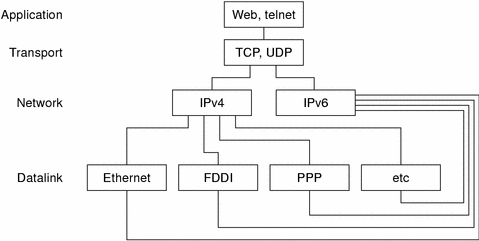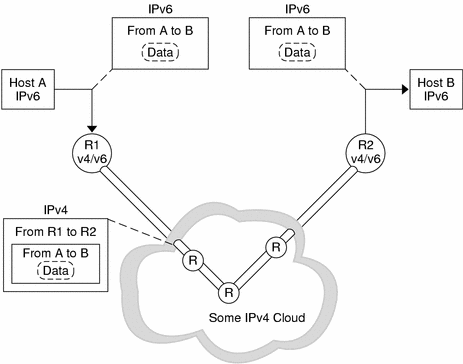Transitioning From IPv4 to IPv6 (Reference)
As hosts and routers are upgraded to support IPv6, the hosts and routers must be able to interoperate over the network with the hosts and router that support only IPv4. This chapter provides an overview of the standardized solutions to transitioning from IPv4 to IPv6. RFC 1933 also provides detailed solutions to the transition problem.
This chapter contains the following information:
Transition Requirements
The transition does not require any global coordination. Your sites and Internet service provider (ISP) can transition at their own pace. Furthermore, an effort has been made to minimize the number of dependencies during the transition. For instance, the transition does not require that routers be upgraded to IPv6 prior to upgrading hosts.
Different sites have different constraints when transitioning. Also, early adopters of IPv6 are likely to have different concerns than production users of IPv6. RFC 1933 defines the transition tools currently available. The rationale for transition is either the lack of IPv4 address space or the required use of new features in IPv6, or both. The IPv6 specification requires 100 per cent compatibility for the existing protocols and existing applications during the transition.
To understand the transition approaches, the following terms have been defined.
IPv4-only node - A host or router that implements only IPv4. An IPv4-only node does not understand IPv6. The installed base of IPv4 hosts and routers that exist before the transition begins are IPv4-only nodes.
IPv6/IPv4 node - A host or router that implements both IPv4 and IPv6, which is also known as dual-stack.
IPv6-only node - A host or router that implements IPv6, and does not implement IPv4.
IPv6 node - Any host or router that implements IPv6. IPv6/IPv4 and IPv6-only nodes are both IPv6 nodes.
IPv4 node - Any host or router that implements IPv4. IPv6/IPv4 and IPv4-only nodes are both IPv4 nodes.
Site - Piece of the private topology of the Internet that does not carry transit traffic for anybody and everybody. The site can span a large geographic area. For instance, the private network on a multinational corporation is one site.
Standardized Transition Tools
RFC 1933 defines the following transition mechanisms:
When you upgrade your hosts and routers to IPv6, the hosts and routers retain their IPv4 capability. Consequently, IPv6 provides compatibility for all IPv4 protocols and applications. These hosts and routers are known as dual-stack.
These hosts and routers use the name service (for example, DNS) to carry information about which nodes are IPv6 capable.
IPv6 address formats can contain IPv4 addresses.
You can tunnel IPv6 packets in IPv4 packets as a method of crossing routers that have not been upgraded to IPv6.
Implementing Dual-Stack
The term dual-stack normally refers to a complete duplication of all levels in the protocol stack from applications to the network layer. An example of complete duplication is the OSI and TCP/IP protocols that run on the same system. However, in the context of IPv6 transition, dual-stack means a protocol stack that contains both IPv4 and IPv6. The remainder of the stack is identical. Consequently, the same transport protocols (TCP, UDP, and so on) can run over both IPv4 and IPv6. Also, the same applications can run over both IPv4 and IPv6.
The following figure illustrates dual-stack protocols through the OSI layers.
Figure 17-1 Dual-Stack Protocols

In the dual-stack method, subsets of both hosts and routers are upgraded to support IPv6, in addition to IPv4. The dual-stack approach ensures that the upgraded nodes can always interoperate with IPv4-only nodes by using IPv4.
Configuring Name Services
A dual node must determine if the peer can support IPv6 or IPv4 in order to check which IP version to use when transmitting. The control of the information that goes in the name service enables a dual node to determine which IP version to use. You define an IPv4 node's IP address and the IPv6 node's IP address in the name service. Thus, a dual node has both addresses in the name service.
The presence of an IPv6 address in the name service also signifies that the node is reachable by using IPv6. However, the node is only reachable by nodes that obtain information from that name service. For example, placing an IPv6 address in NIS implies that the IPv6 host is reachable by using IPv6. However, the IPv6 host is only reachable by IPv6 and dual nodes that belong to that NIS domain. The placement of an IPv6 address in global DNS requires that the node is reachable from the Internet IPv6 backbone. This situation is no different than in IPv4. For example, the mail delivery operation requires that IPv4 addresses exist for nodes that can be reached by using IPv4. The same situation is true for the HTTP proxy operation. When no reachability exists in IPv4, for instance, because of firewalls, the name service must be partitioned into an inside firewall and outside firewall database. Consequently, the IPv4 addresses are visible only where the IPv4 addresses are reachable.
The protocol that is used to access the name service is independent of the type of address that can be retrieved from the name service. This name service support, coupled with dual-stacks, allows a dual node to use IPv4 when communicating with IPv4-only nodes. Also, this name service support allows a dual node to use IPv6 when communicating with IPv6 nodes. However, the destination must be reachable through an IPv6 route.
Using IPv4-Compatible Address Formats
In many instances, you can represent a 32-bit IPv4 address as a 128-bit IPv6 address. The transition mechanism defines the following two formats.
IPv4-compatible address
000 ... 000
IPv4 Address
IPv4-mapped address
000 ... 000
0xffff
IPv4 Address
The compatible format is used to represent an IPv6 node. This format enables you to configure an IPv6 node to use IPv6 without having a real IPv6 address. This address format enables you to experiment with different IPv6 deployments because you can use automatic tunneling to cross IPv4-only routers. However, you cannot configure these addresses by using the IPv6 stateless address autoconfiguration mechanism. This mechanism requires existing IPv4 mechanisms such as DHCPv4 or static configuration files.
The mapped address format is used to represent an IPv4 node. The only currently defined use of this address format is part of the socket API. An application can have a common address format for both IPv6 addresses and IPv4 addresses. The common address format can represent an IPv4 address as a 128-bit mapped address. However, IPv4-to-IPv6 protocol translators also allow these addresses to be used.
Tunneling Mechanism
To minimize any dependencies during the transition, all the routers in the path between two IPv6 nodes do not need to support IPv6. This mechanism is called tunneling. Basically, IPv6 packets are placed inside IPv4 packets, which are routed through the IPv4 routers. The following figure illustrates the tunneling mechanism through routers (R) that use IPv4.
Figure 17-2 Tunneling Mechanism

The different uses of tunneling in the transition follow:
Configured tunnels between two routers (as in the previous figure)
Automatic tunnels that terminate at the dual hosts
A configured tunnel is currently used in the Internet for other purposes, for example, the MBONE (the IPv4 multicast backbone). Operationally, the tunnel consists of two routers that are configured to have a virtual point-to-point link between the two routers over the IPv4 network. This kind of tunnel is likely to be used on some parts of the Internet for the foreseeable future.



